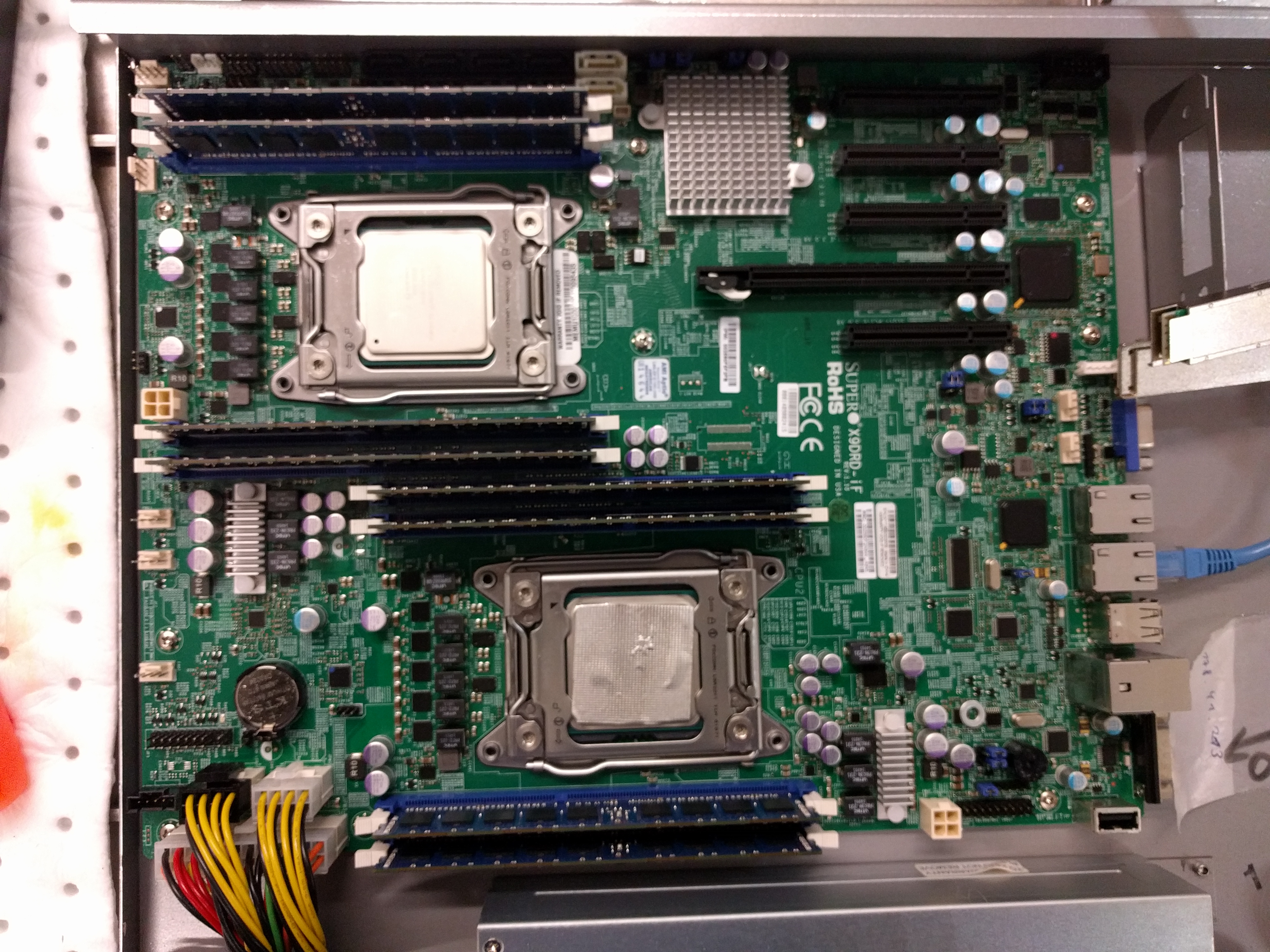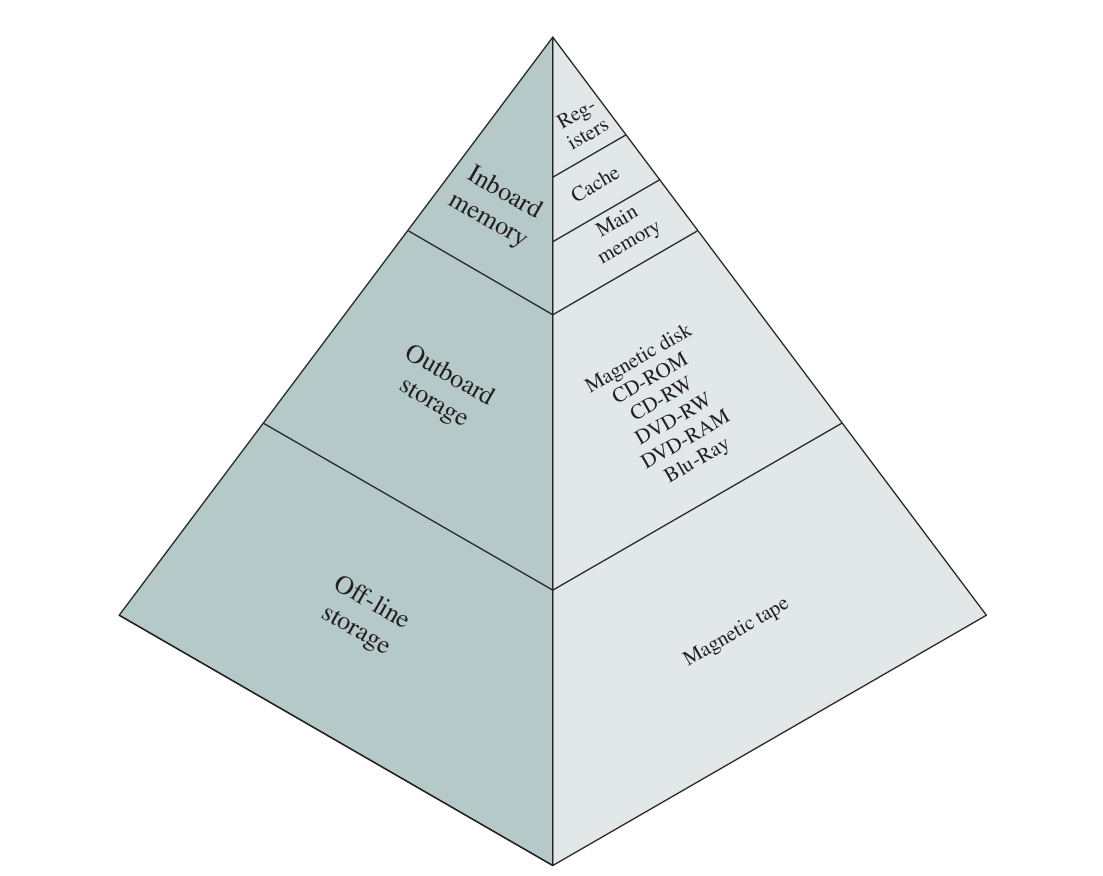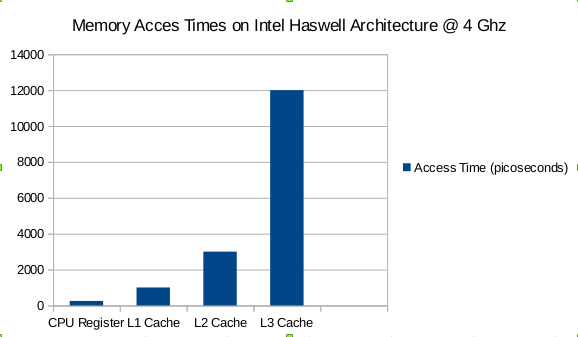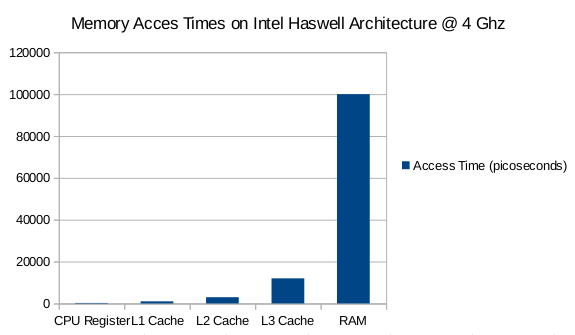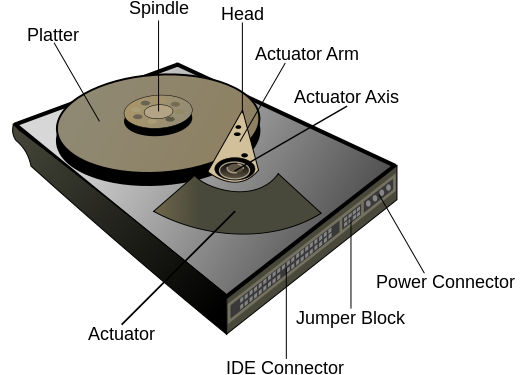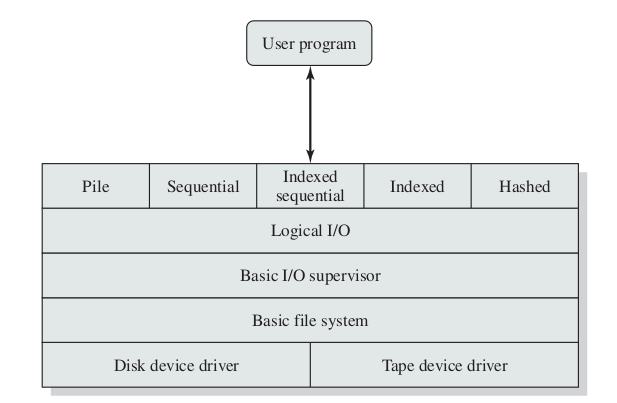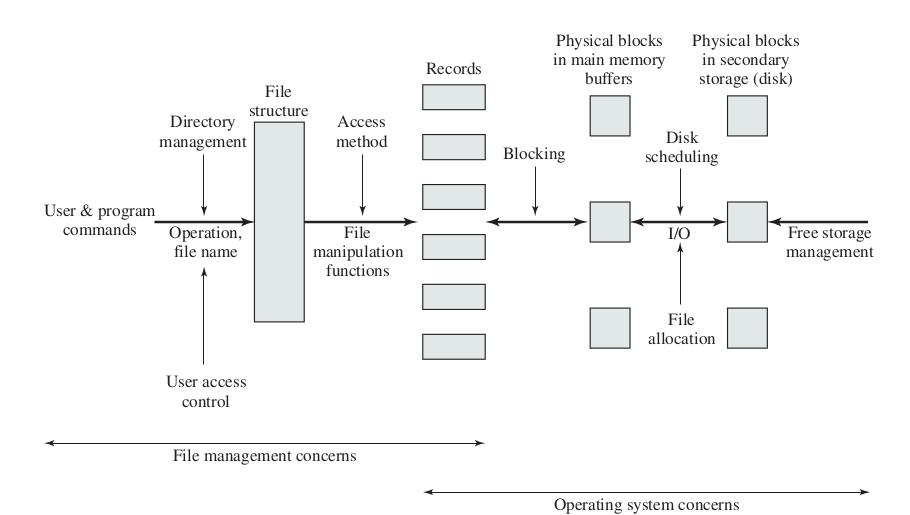Table of Contents
Storage Technologies - Welcome
“Computers are like Old Testament gods; lots of rules and no mercy.” (Joseph Campbell)
<!– “Simple things should be simple. Complicated things should be possible.” (Alan Kay) –!>
<!– “Computer sciene is not about machines, in the same way that astronomy is not about telescopes. […] Science is not about tools, it is about how we use them and what we find out when we do.” (Michael R. Fellows) –!>
Storage Technologies - Contents
- Hardware Basics
- Memory Hierarchy
- Storage Devices
- Flash-Memories
- Harddisks
- Magnetic Tapes
- Multi Tiered Storages / Hierarchical Storage Systems
- File Systems
- Local
- Network
- Distributed
Storage Technologies - Hardware Basics
Storage Technologies - Hardware Basics
- CPU
- Central Processing Unit
- Controls Operation and performs data processing
- Registers and Caches for fast data access
- Main Memory
- Stores data and programs
- Typically volatile
- I/O Modules
- Move data between CPU/Memory and external devices
Storage Technologies - Hardware Basics (II)
- System Bus
- Provides Communication among processor, memory and I/O modules
- ISA, PCI, AGP, PCI-Express, …
- External Devices
- I/O Controllers (HBA / RAID)
- Network Controllers (Ethernet, Fibre Channel, Infiniband)
- Human Interface Devices (Keyboard, Mouse, Screen, etc.)
Storage Technologies - Direct Memory Access
- Traditionally copying of data from/to devices was done with cpu registers
- Costs a lot of clock cycles that could be used for processing (up to 40 clock cycles per word)
- DMA - Direct Memory Access
- DMA-C is integrated in modern chipsets
- Moves data from external devices to memory and vice versa
- Informs the system when copying is done (interrupt)
- Still some cycles needed for communication with the controller
- Performance gets better the more data is transferred. Byte-wise DMA is a bad idea.
Memory Hierarchy (I)
Memory Hierarchy (II)
- Inboard Memory
- Registers
- Caches
- RAM
- Outboard Storage
- Flash-Drives
- Disks
- Blu-Ray / DVD / CDRom
- Off-Line Storage
- Magnetic Tapes
Memory Hierarchy (III)
- Why?
- SRAM is expensive
- Trade-off among speed, cost, size, and power consumption
- Strategies
- Caching
- Prefetching
- Need data locality
Memory Hierarchy (IV)
- As one goes down the hierarchy…
- Decreasing cost per bit
- Increasing capacity
- Decreasing frequency of access
- Increasing access time
Memory Hierarchy (V)
- Memory Access Times on Intel Haswell Architecture 1 Clock Cycle = 250 picoseconds @ 4 Ghz (Movement at speed of light = 7.5 cm per 250 picoseconds)
- Processor Registers
- 1 Clock Cycle (250 ps)
- Cache (L1)
- Access Time ~4-5 Clock Cycles (~ 1 ns)
- Cache (L2)
- Access Time ~12 Clock Cycles (~ 3 ns)
- Cache (L3)
- Access Time ~36-58 Clock Cycles ( ~ 12 ns)
- RAM
- Access Time ~30-60 Clock Cycles + 50-100 ns ( ~ 70 - 120 ns)
Memory Access Times
Memory Access Times (II)
Memory Hierarchy (VI)
- Storage Devices Typical Access Times
- NVMe Flash Memory ~ 6 µs (@ 150’000 IOPS)
- SAS Magnetical Disk ~ 2-3 ms (@ 350 IOPS)
- Magnetical Tape milliseconds up to many seconds
Caching
Storage Technologies - Cache Memory
- Acts as a buffer between 2 memory tiers
- Modern CPUs utilize 3 levels of caches
- Level 1 split into instruction and data cache. Separate for each core.
- Level 2 data and instruction cache. Separate for each core.
- Level 3 data and instruction cache. Shared among all cores on the die.
- Benefits both throughput and latency
- Different Caching Strategies for different purposes
Caching Strategies
- Cache Hit vs. Cache Miss
- Cache Hit Ratio
- Replacement Strategies / Associativity
- Direct Mapped
- N-Way Set Associative (But: Increased N means more potential locations need to be searched)
- Fully Associative
- Write Strategies
- Write Back
- Write Through
- Prefetching / Readahead
Caching Problems
- Larger Caches have higher hit-rate but also higher latency
- Multi Level Caches
- Data may become incoherent particularly in multiprocessor systems –> Cache Coherency Protocol
- Write Propagation
- Transaction Serialization (Reads/Writes to a memory location must be seen in the same order by all processors)
Storage Technologies - Why Caching Works –> Locality of reference
- Memory References tend to cluster.
- Program execution is sequential
- Instructions tend to be localized to a few procedures
- Iterative constructs consist of a small number of instructions
- Processing of data structures, like arrays or sequences
- Spatial locality
- Execution involves a number of memory locations that are clustered
- Acessing data locations sequentially
- Spatial locality can be exploited by using large cache blocks and prefetching
- Temporal locality
- Execution involves memory locations that have been accessed recently
- Temporal locality can be exploited by keeping recently used values in cache
- Locality of reference enables us to do caching and prefetching
- It also enables us to do branch prediction and other things, but this goes beyond the scope of this course
Caching - Example
int sizeX = 2000; int sizeY = 1000; int array[sizeY][sizeX]; // Fill the array with some data fill_buffer(&array); // Now run through the array and do something with the elements // This runs slow in C for (int x=0; x<sizeX, x++) { for (int y=0; y<sizeY; y++) { array[y][x] = x+2000*y; } } // This runs fast in C for (int y=0; y<sizeY, y++) { for (int x=0; x<sizeX; x++) { array[y][x] = x+2000*y; } }
Memory Hierarchy - Recap
- Problem: A CPU waiting for data can’t do any work
- Low Memory Access Times are crucial
- Solution: Caching/Prefetching algorithms.
- Works well with sequential data / local data access patterns
- Won’t work with totally random access patterns (Locality)
- As one goes down the hierarchy
- Increasing access time
- Decreasing throughput
- Also known as “Von Neumann Bottleneck”
Storage Technologies (I)
- I/O Devices
- Human Readable
- Machine Readable
- Communication
- Differences in
- Data Rate
- Application
- Complexity of Control
Storage Technologies (II)
- Across the different storage technologies, these relationships seem to hold:
- Faster access time, greater cost per bit
- Greater capacity, smaller cost per bit
- Greater capacity, slower access speed
Storage Technologies - Device Characteristics (I)
- Performance
- Access Time / Latency
- Throughput
- Capacity
- Raw capacity
- Storage density
- Volatility / Differentiation
- Dynamic Memory (periodic refreshes required)
- Static Memory
Storage Technologies - Device Characteristics (II)
- Mutability
- Read/Write
- Read Only
- Slow Write, Fast Read (e.g. SMR Discs)
- Accessibility
- Random Access
- Sequential Access
- Adressability
- Location addressable
- File addressable
- Content addressable
Sequential I/O vs. Random I/O
- Sequential I/O
- Writing / Reading contiguous large chunks of data (Chunk Size >= 10E6 Bytes)
- Usually the fastest way to read data from storage devices
- Not always easily applicable to a problem
- Random I/O
- Writing / Reading small chunks of data to / from random locations (Chunk Size ⇐ 10E4 Byte)
- Slowest way to read data from storage devices
- Magnitude of the slow-down depends on the underlying hard- and software (e.g. Tape-Drives vs. Flash-Drives)
Hard-Drives Overview (I)
- Invented in the mid 50s by IBM
- The first IBM drive stored 3.75 MB on a stack of 50 discs
- Had the size of two refrigerators (1.9 m³)
- Became cheap / mainstream in the late 80s
- Today one 3.5“ drive can hold up to 14TB of data
- Density ~ 1.5 Tbit / in²
- With future technologies even higer data densities may become possible
- Filling disks with helium
- Shingled Magnetic Recording
- Heat Assisted Magnetic Recording
- Interface
- Serial Attached SCSI (SAS)
- SATA
- NVMe
Hard-Drives Overview (II)
- Video of operating harddisk on wikipedia: https://upload.wikimedia.org/wikipedia/commons/c/c5/HardDisk1.ogv
Hard-Drives Characteristics
- Seek Time
- The time it takes to move the head to the correct track
- Rotational Delay
- The time it takes until the platter rotates to the correct position ( ~2ms @ 15’000 rpm)
- r… rotation speed in revolutions per second
- $T_{rdelay} = 1/2r$
- Transfer time calculation
- T… Transfer Time
- b… Number of bytes to be transferred
- N… Number of bytes per track
- r… rotation speed in revolutions per second
- $T = b/rN$
- Average Access Time
- $T_{access} = T_{seek} + T_{rdelay} + T_{transfer}$
Hard-Drives Sequential Access Example
- Do not rely on average values!
- Given a Harddisk with
- Rotational speed of 7’500 rpm
- 512 byte sectors
- 500 sectors per track
- We read a file that is stored on 5 adjacent tracks in 2500 sectors (1.28 MBytes)
- Average seek… 4ms
- Rotational delay… 4ms
- Read 500 sectors… 8ms
- We need to do this 5 times (1 for each track), but because of sequential organization we can skip the seek time for the consecutive tracks
- $T_{total} = 16 + (4 * 12) = 64 ms$
Hard-Drives Random Access Example
- Given a Harddisk with
- Rotational speed of 7’500 rpm
- 512 byte sectors
- 500 sectors per track
- We read a file that is distributed randomly over 2500 sectors of the disk
- Average seek… 4ms
- Rotational delay… 4ms
- Read 1 sector… 0.016ms
- We need to do this 2500 times with a seek after each sector
- $T_{total} = 2'500 * 8.016 = 20'040 ms = 20.04s$
- Slowdown of nearly 3 orders of magnitude with the same average values
- Do not rely on average values!
Quo vadis Hard-Drives
- Current/Future Trends
- Helium filled drives
- Shingled Magnetic Recording
- Heat assisted recording
(NVMe) Solid State Drives (I)
- NAND Flash Memory
- Lower cost compared to DRAM
- No refresh cycles / external PSU needed to retain the data compared to DRAM
- Uses less space compared to memory based on NOR gates
- No random access (Cells are connected in series to sectors)
- Key components
- Controller
- Memory
- New Interfaces
- SATA Express
- NVM Express
(NVMe) Solid State Drives (II)
- NAND Flash Memory
- Single Level Cell (SLC)
- Multi Level Cell (MLC)
- SLC
- 1 bit per cell
- ~10 times longer life than MLC
- Lower latency than MLC
- MLC
- multiple bits per cell
- Lower production cost
(NVMe) Solid State Drives - Memory (I)
- NAND Flash Memory
- Is composed of one or more chips
- Chips are segmented into planes
- Planes are segmented into thousands (e.g. 2048) of blocks
- And 1 or 2 registers of the page size for buffering
- A Block usually contains 64 to 128 pages
- Each page has a data part (few KBytes)
- and a small metadata area (e.g. 128 bytes) for Error Correcting Code
- Exact specification varies across different memory packages
(NVMe) Solid State Drives - Memory (II)
- Read
- Is performed in units of pages
- 1 page takes approx. 10 µs (SLC) up to 100 µs (MLC) to read
- Write
- Is performed in units of pages
- Some controllers support sub-page operations
- Pages in one block must be written sequentially
- A page write takes approximately 100 µs (SLC) up to 900µs (MLC)
- Block must be erased before being reprogrammed
(NVMe) Solid State Drives - Memory (III)
- Erase
- Must be performed in block granularity (hence the term erase-block)
- Can take up to 5 ms
- Limited number of erase cycles
- SLC: 100’000
- MLC: 10’000
- Some flash memory is reserved to replace bad blocks
- Controller takes care of wear leveling
(NVMe) Solid State Drives - Controller (I)
- Higher complexity of access compared to hard-disks
- High performance SSDs consists of hundreds of dies with parallel communication paths
- Data cells may wear out and become bad
- Erase size != Page size
- We need a controller to handle this:
- Does the initial setup
- Format the memory
- Mark bad blocks
- Moves data and picks blocks so that single cells don’t wear out
- Parallelizes read/write/erase operations on many dies
- Adresses in Blocks/Pages
- Flash Transition Layer and Logical to Physical Mapping
- Garbage Collection
(NVMe) Solid State Drives - Speed (I)
- Besides the additional complexity, SSDs are much faster than traditional disks
- Read Latency is in the order of few microseconds (We had milliseconds with HDDs)
- No need to move the head around
- But because of the arrangement in blocks and pages, sequential access is still faster
- More IOPS because of the lower latency
- Needs more CPU utilization to get full throughput
- Needs some pressure (multiple calls) to fully parallelize read/write calls
- This is also called ‘Queue Depth’
(NVMe) Solid State Drives - IOPS vs. Throughput
- Traditional discs have been measured in terms of throughput
- SSDs are sometimes measured in terms of IOPS (Input- Output- Operations per Second)
- The following equation holds (if there is no controller overhead like erasing, garbage collection, etc.):
- $Throughput = IOPS * Blocksize$
- Where blocksize can be chosen freely
- So if we know the blocksize that was used in benchmarking…
- We can calculate IOPS from throughput and vice versa
- (If we assume that the disk was empty at the beginning of the benchmark and no additional controller overhead was involved)
- We now even have a base to calculate which blocksize is at least necessary to get full write throughput
(NVMe) Solid State Drives - Speed (II)
- Given an Intel DC P3700 SSD with a capacity of 2 TB, specification says:
- Sequential Read 450’000 IOPS with 2800MB/s of max throughput
- $2'800'000'000 Bytes = 450'000 * x$
- $x = 6222 Bytes ~ 6KByte$
- So a blocksize of 8 KByte is a good starting point to try to get full throughput
- Random Reads with a page size of 8KByte should work well on this device and we should get the full throughput of 2800MB/s
- How would a traditional HDD perform under these conditions?
(NVMe) Comparison SSD vs. HDD
- In the slide before, we proposed that on our SSD with a block size of 8 KByte will lead to a throughput of 2800MB/s
- Let’s try this with a HDD
- Rotational speed of 7’500 rpm
- 512 byte sectors
- 500 sectors per track
(NVMe) Comparison SSD vs. HDD
- We read a file that is distributed randomly over 2500 sectors of the disk in blocks of 8KByte (Blocks of 16 sectors)
- Average seek… 4ms
- Rotational delay… 4ms
- Read 16 sectors… 0.256ms
- We need to do this 156.25 times with a seek after every block of 16 sectors
- $T_{total} = 156.25 * 8.256 = 1290 ms = 1.290 s$
- We transferred 156.25 * 8 KBytes = 1250 KBytes in 1.290 s
- This equals ~ 1 MByte per second (SSD 2800 MByte per second)
- With the same block size our benchmark will run ~2800 times faster on SSD than on HDD
- When utilised in sequential form, HDDs are still 20-30 times slower than high performance SSDs
(NVMe) Solid State Drives - Speed (II)
- $Transfertime = T_{controller} + T_{transfer}$
Quo vadis Solid State Drives
- Current / Future Trends
- Flash Memory Market surpassed DRAM Market in 2012
- Density of Flash Memory surpassed Hard Drive density in 2016
- In Q4 2016 45 million SSDs with a total capacity of 16 Exabyte were delivered to customers
- Market for HDDs is significantly bigger than for SSDs
- New memory technologies (e.g. Intel/Micron 3DXPoint)
- Intel Optane Memories
- Things to consider
- Will SSDs replace all HDDs in the future?
- All Flash SDS
- Storage as Memory
- Everything except archive
- What use cases remain for HDDs?
Magnetic Tapes (I)
- Have been in use for data storage since the 50’s
- Main storage medium in some early computers
- Capacity:
- 1950’s: ~ 1 MByte
- 1980’s: ~ 100 MByte - 1 GByte
- 1990’s: ~ 10 - 100 GByte
- 2000’s: ~ 100 GByte - 1 TByte
- Now: >10 TByte
- Future: Going up to 200 TByte per Tape seems possible
- Real tape capacity is usually 1/2 of the given capacity
- A compression ratio of 2:1 is quietly assumed
Magnetic Tapes - Characteristics (I)
- Tape width
- Half inch has been the most common width
- Recording Method
- Linear
- Linear Serpentine
- Scanning (writing across the width of the tape)
- Helical Scan (Short, dense, diagonal tracks)
- Block Layout
- Data is written in blocks, each block is a single operation
Magnetic Tapes - Characteristics (II)
- Access
- Sequential Access
- Index database or Tape Marks
- Compression
- Data is usually compressed when written on tape
- Encryption
- Data encryption is possible and standardised
- Encryption needs to be done after compression
- Why?
Magnetic Tapes - Characteristics (II)
- Access
- Sequential Access
- Index database or Tape Marks
- Compression
- Data is usually compressed when written on tape
- Encryption
- Data encryption is possible and standardised
- Encryption needs to be done after compression
- Encrypted data should look like random noise
- If your encrypted data is compressible then your encryption is flawed
Magnetic Tapes - LTO
- Linear Tape Open
- Open standard to store data on magnetic tapes
- Developed in the 90’s
- Eigth Generation LTO was released in 2017
- LTO-8 State of the art
- 12 TByte raw capacity (uncompressed)
- 360 MByte/s max uncompressed speed
- Compression ratio 2.5:1
- Supports encryption
- Supports WORM (Write once read many)
Magnetic Tapes - No random I/O
- The loading and winding of the tape takes a long time (up to many seconds)
- Tape moves at a constant speed
- Modern tape machines can move at 1/2 or 1/4 speed
- Shoe shining happens when there is not enough data to write
- Wears out the tape
- Doing random reads wears out the tape
- Expected durability of a tape is about 10^4 end-to-end passes
Memory Hierarchy - cont’d
- With the given storage technologies (Flash, HDD and Tape) we can refine our Memory hierarchy
- Using Flash Memories for Caching and Metadata
- Using HDDs as online data storage
- Using Tapes as offline data storage
- With the concept of locality and the right applications this will speed up our storage stack
- Recently random accessed files and Metadata that fits on the SSDs will be stored on the SSDs
- Recently sequential acessed files will be moved to the HDDs (They are fast enough when used in a sequential way)
- Rarely acessed files go to the tape machine
- We could even link these files transparently into the file system, so the user doesn’t have to know anything about where his data is located
Multi Tiered Storage Systems
- Different Tiers of Storage e.g.
- Tier 1: SSDs
- Tier 2: SATA HDDs
- Tier 3: Tape Storage
- But there’s no free meal
- We need to store data about where our data is stored (More on metadata later on) –> Memory Overhead
- If a user accesses a file, we need to check where the file is –> Processing Overhead
- In the worst case we have to copy it from tape to the disk
- which means loading the right tape and winding to the correct position
- which also means that the user might think, that the storage is very slow today
Gaining speed and redundancy with RAID
- RAID - Redundant Array of Independent (Inexpensive) Discs
- Distribute data across several drives
- Add parity calculation or mirroring for redundancy
- Different Techniques / RAID Levels available
- RAID 0, 1, 5, 6, 10, 01, …
- Several Discs in a RAID are called a RAID array
RAID - Striping and Mirroring
- RAID Level 0
- Data is striped across drives without redundancy
- Failure of one disc leads to loss of all data in the array
- Speedup is proportional to the number of discs
- RAID Level 1
- Data is mirrored across discs (usually 2, but more are possible)
- Failure of a disc involves no loss of data
- Read calls can be parallellized to multiple discs
- No speedup for write calls
RAID - Parity
- RAID Level 5
- Data is striped across drives, parity is calculated (XOR) and stored
- Block level striping
- Failure of one disc can be compensated
- Failure of more than one discs leads to data loss
- Considered obsolete nowadays, because of long rebuild times
- Use RAID-6
- RAID Level 6
- Data is striped across drives, parity is calculated and stored
- 2 different syndromes are computed to allow the loss of up to two drives
- Additional computation needed (no simple XOR for the second syndrome)
RAID - Other Levels
- “Hybrid”-RAID
- Mirroring between SSD and HDD (special controller needed)
- Nested-RAID
- RAID-10
- Stripe of Mirrors
- RAID-01
- Mirror of Stripes
- Most probably RAID-10 is the better choice than RAID-01
- Improved fault tolerance
But where are the levels 2 - 4 ?
- RAID2 - RAID4 are obsolete
- RAID2
- Bit level striping with dedicated parity disc
- RAID3
- Byte level striping with dedicated parity disc
- RAID4
- Block level striping with dedicated parity disc
File Management
- Abstraction of the secondary storage
- After all we don’t want to cope with the internals of storage devices
- Abstraction to Files / Directories –> File System
- Files
- Long-term existence
- Sharable between processes
- Structure
- Files can have internal structure (e.g. databases)
- Operations
- Create
- Delete
- Open
- Close
- Read
- Write
File Management - Inodes (I)
- Besides the file content, filesystems rely on data structures about the files
- Also called Metadata
- Inodes store information about files
- Type of File (File, Directory, etc)
- Ownership
- Access Mode / Permissions
- Timestamps (Creation, Access, Modification)
- Last state change of the inode itself (status, ctime)
- Size of the file
- Link-Counter
- One or more references to the actual data blocks
File Management - Inodes (II)
- Most filesystems use a fixed amount of inodes
- Ext2 filesystem can address up to 12 blocks per inode
- If more blocks are needed for a file a new inode is allocated (indirect block)
- Ext2 allows up to triple nested indirect blocks which leads to a maximum size of 16 GiB to 4 TiB depending on block-size
- Appending to files and writing new files is not possible when inodes run out
- Depending on the amount of files/directories a filesystem can use up to 10% of its capacity for meta information
- Show Inode Number with ‘ls -i’
- Show content with stat
File Management - Inodes (III)
* sreinwal@rs ~/Work/vboxshared/sreinwal/pandoc/vsc-markdown/parallell-io/02_storage_technologies $ stat storage_technologies.md * File: storage_technologies.md * Size: 30837 Blocks: 64 IO Block: 4096 regular file * Device: fd04h/64772d Inode: 25373850 Links: 1 * Access: (0644/-rw-r--r--) Uid: ( 1001/sreinwal) Gid: ( 1001/sreinwal) * Access: 2017-11-28 14:25:11.191823770 +0100 * Modify: 2017-11-28 14:23:53.482827520 +0100 * Change: 2017-11-28 14:25:20.416823325 +0100 * Birth: -
File System - Organization (I)
File System - Organization (II)
- Device Drivers / Hardware Layer
- Dealing with I/O operations on the devices
- Usually considered part of the operating system
- Basic File System / Physical IO Layer
- Deals with blocks of data, that are exchanged with device drivers
- Manages placement of blocks and the buffering of these blocks in main memory
File System - Organization (III)
- Basic I/O supervisor / Basic I/O Layer
- Responsible for file I/O and its termination
- Control structures are maintained to deal with device I/O, scheduling and file status
- Disk-Scheduling to optimize performance
- Logical I/O Layer
- Provides general purpose file I/O
- Maintains basic data about files
- Enables users/applications to access files
File System - Organization (IV)
Unix File Management
- 6 different types of files
- Regular
- Contains data. Simple stream of bytes.
- Directory
- Contains list of file names plus pointers to their index nodes
- Special
- Map physical devices to files (e.g. /dev/sda for the first SAS/SATA disc)
- Named pipes
- Buffers received data
- Enables interprocess communication
- FIFO (First-In-First-Out)
- Links
- Alternative filenames for existing files
- Symbolic Links
- Basically an ordinary file that contains the name of the file it is linked to
Linux Virtual File System
- Different File Systems under Linux
- ext2, ext3, ext4, reiserfs, xfs, nfs, …
- VFS provides a virtual file system
- Presents a single, uniform interface to user processes
- Mapping between VFS and underlying file system
Storage Networks - NAS vs. SAN
- NAS - Network Attached Storage
- Centralized File Storage
- Exporting File-Systems for clients to mount
- Connected via Network (Ethernet, Infiniband, …)
- File System Layers of the server are used
- User/Access Management at the server
- SAN - Storage Area Network
- Centralized Device Array
- Exports Block devices
- Connected via Fibrechannel
- ISCSI Protocol, NVMoF Protocol
- Client is responsible for handling file systems on the block device
- No User/Access Management at block level
Distributed File Systems - NFSv4
- NFSv4
- Network File System Version 4
- Client Server Architecture
- Provides a standardized view of its local filesystem
- Allowing a heterogenous collection of processes to share a common filesystem
- Allows sharing of all local filesystems as well as other network filesystems
- VFS layer comes in handy here
- NFS4 uses Remote File Service / Remote Access Model
- File stays on the server
- Locking Mechanisms (Stateful Model)
- NFSv2 and NFSv3 were stateless which led to some problems (Separate Locking daemon needed)
- Opposed to the Upload/Download Model
- Client downloads file, does operations locally, reuploads the file
Client Side Caching - Asynchronous I/O
- Synchronous or Blocking I/O
- Process issues an I/O call to the operating system and waits for the operation to complete
- Leads to intervals where the CPU is completely idle waiting for the operation to finish
- Asynchronous or Non-Blocking I/O
- As we have seen, I/O Operations can be very slow
- Client calls the operating systems for a read/write
- Continues processing
- Data is read/written in the background
- Operating system informs the process when the file is written
- Client side caching in NFS
- async mount option
- data is cached on the client
Server Side Caching - NFSv4
- Server Side Caching
- Server replies to requests before they have been committed to stable storage
- Usually less error prone than client side caching, because servers are usually in a more controlled environment than clients
- e.g. Uninterruptible Power Supply, BBU Units on RAID controllers, etc.
- Problems arise
- Server crashes before data is transferred from client to server
- Client crashes before it transfers data to server
- Network connection breaks
- Power outages
- etc…
Parallell File Systems - BeeGFS
- FhGFS / BeeGFS Parallell File System
- Distributes data and metadata across serveral targets
- Stripes data across several targets
- Huge speedup compared to single server appliances
- Scalability and Flexibility were key aspects for the design
BeeGFS - Management Server
- Management Server
- Exactly 1 MS per filesystem
- Keeps track of metadata and storage targets
- Keeps track of connected clients
- Tags targets with labels
- Normal
- Low
- Critical
- Not involved in filesystem operations
BeeGFS - Metadata Server
- Holds the Metadata information of the file system
- Should be stored on fast storage devices (e.g. Flash Memories)
- Metadata accesses are mostly tiny random accesses
- Ext4 seems to be the fastest filesystem to store beegfs metadata
- Additional servers can be added on demand
- Each server holds exactly one metadata target
- TargetChooser
- Chooses targets according to the configuration when a user writes a file
- Holds metadata information
- File / Directory information
- Creation date
- Striping pattern
- Affected Storage Targets
- Permissions
- ACLs
- Extended attributes
- …
BeeGFS - Metadata Server
- Entry point of the file system ‘/’ is located on MDS #1
- Defined entry point in the directory tree
- Additional directories are assigned random to other MDS
- Leads to effective load balancing on the metadataservers
- As long as there are significantly more directories than metadata targets
- Client walks down the directory tree to find the responsible MDS for a directory
- Handling Meta-Data requests is creating some load on the cpu cores
- For a small number of requests higher clock speeds lead to less latency
- For a high number of requests multiple CPU Cores are needed
- Metadata handling will create processes which are waiting for data
- CPU overcommitting could increase performance
BeeGFS - Object Storage Server
- Holds the file contents on Object Storage Targets (OSTs)
- Underlying devices / filesystem can be chosen freely
- As long as the file system is POSIX compliant
- File contents can be striped over multiple OSTs
- One server can handle multiple OSTs
- A typical OST consists of 6 - 12 drives running in RAID6
- Number of threads influence the number of requests that can be put on disk
- Higher number of threads will lead to randomization of sequential data
- We have to live with that to a certain extent in multi user environments
- Chunksize sets the amount of data stored on a OST per stripe
- OSTs can be added on demand. But a rebalancing of the file system might be needed to gain full performance
BeeGFS - Clients
- Clients can be added on demand
- Thousands of clients is no problem as long as there are enough MDTs and OSTs available
- tuneFileCacheType - Client caching is supported
- Buffered Mode
- Uses a pool of static buffers for write-back and read-ahead
- Caches up to a few hundred kilobytes of a file
- Default Mode
- Native Mode
- Uses the linux kernel page cache
- May cache up to multiple gigabytes of data (depending on the available RAM)
- Experimental / Work in progress
Theres much more
- Different Storage Devices
- Optical
- Laserdisc / CD-Rom / DVD / Blu-Ray
- Magnetic
- Floppy / ZIP Drives
- Magneto-Optical
- Minidisc (Sony)
- Different Parallell File Systems
- GPFS
- GlusterFS
- Lustre
- Different use-cases
- Storage Area Network
- Different architectures
- HP - The Machine
Storage Technologies - Bibliography
- Understanding Intrinsic Characteristics and System Implications of Flash Memory Based Solid State Drives, Cheng et al., 2009
- Operating Systems - Internals and Design Principles 7th Edition, Stallings, 2012
- Distributed Systems - Principles and Paradigms 2nd Edition, Tanenbaum et al., 2007
Storage Technologies - The End
- Remember
- Random I/O is magnitudes slower than sequential I/O
- Sequential I/O can even be done in parallell from multiple nodes to further improve the throughput
- Highly parallellized Random calls will result in degraded storage performance for ALL users and can even lead to an unresponsive storage.
- Don’t do random I/O on storage devices
Thank you for your attention
